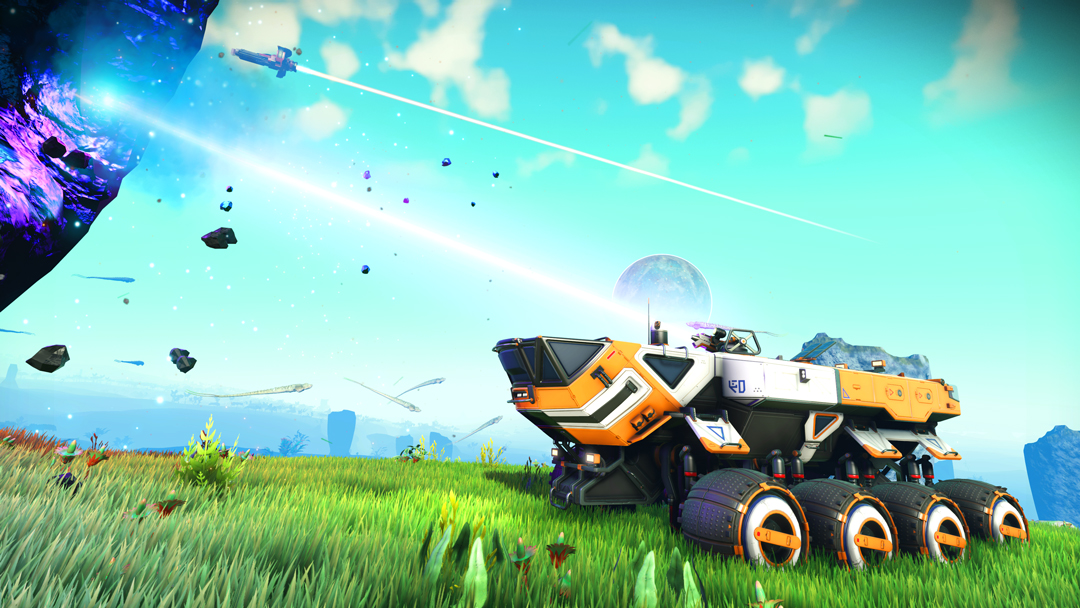What is it that makes the open world style interesting?
I’d argue it’s this: chance. Hence the acquainted chorus of “you can go there” that accompanies open world preview trailers or screenshots displaying us distant mountain ranges – the promise that you simply, and even perhaps the builders themselves, by no means know precisely what you would possibly discover whenever you enterprise out. The innate attraction of being unsure about what lies past the horizon is what these games are predicated on.
No Man’s Sky was presupposed to be the final word expression of chance. It’s “you can go there” promise beat each different pitch that got here earlier than it, blowing our collective minds with its unfathomable scale. This was a de facto infinite universe, the logical endpoint of an trade bragging about how sequels had maps 5 occasions the dimensions of their predecessors, or provided nonetheless many a whole bunch of hours of gameplay. This was, for some, the realisation of the dream of what video games might be. It turned out that what video games might be was actually, actually huge – and a bit boring.
Here we come to Outer Wilds. The game shares some superficial similarities with No Man’s Sky – each provide you with a spaceship, allow you to launch your self into the good void, and encourage you to discover the planets you discover there. In Outer Wilds, nonetheless, you’re confined to a handful of planets in a single photo voltaic system. That nonetheless seems like lots, however the game is tiny compared to lots of its open world contemporaries.
Within the logic of a style that has an uneven concentrate on the frontier of scale as //the// means by way of which to evoke an ever higher sense of chance, Outer Wilds bounded nature ought to imply it can’t compete with No Man’s Sky on the subject of the core of what makes open worlds compelling. Yet, the alternative is true. A big scale and the invocation of a way of chance aren’t intrinsically linked, it might appear. Our considering round how open worlds work requires some tweaking.
Our start line must be to keep in mind that scale works in two instructions. As properly as broadening out, we are able to zero in. Detail and intricacy are simply as efficient a way of providing us extra to discover as rising the quantity of the house we are able to play in. Think, for instance, of the way in which you navigate the Dishonored sequence’ semi-open world ranges. Multiple routes dovetail with an interlocking net of programs and techniques to create a latticework of potentialities in a small house. Pay consideration to the main points – a doc, a line of dialogue – and new potentials are yielded which, considerably, additionally hints on the existence of undiscovered secrets and techniques they might, or might not, exist elsewhere. This use of intricacy in structure, a fancy interplay of programs, and an consciousness of the facility of contingency, will increase the sense of what’s doable in these games’ areas in a manner that makes them really feel much more open than different titles 100 occasions their measurement.
We can apply this lens to Outer Wilds and No Man’s Sky. Outer Wilds’ planets will not be huge, however they’re intricate. They require totally different methods that have to be discovered by way of lively experimentation, accident, and the acquisition of data to navigate. They play by totally different guidelines: you encounter anti-grav partitions, collapsing planets, teleportation gadgets, and even quantum areas that require you to jettison your dedication to fundamental legal guidelines of physics and rethink your assumptions about how you can discover bodily house. The selection and creativeness you encounter in Outer Wilds’ spectacular areas ties in fantastically with the clues you uncover as you discover the photo voltaic system that present hints about about areas and the principles that decide how one can entry and navigate them. Because the discoveries you’ve already made have been so splendidly shocking, these obscure teases excite the explorer inside you, retaining you keen to seek out out what a game that repeatedly upends your expectations may need in retailer for you subsequent. Like Dishonored, its comparatively small measurement doesn’t cease it from feeling filled with chance.
Compare this to No Man’s Sky. Technically talking, the chances for discovery outweigh something another game can supply. Yet, this promise feels empty. No Man’s Sky’s procedurally generated planets are totally different, however they don’t power you to vary your strategy to them to the diploma that Outer Wilds does, nor are they’re designed round an concept or theme. The planets in No Man’s Sky are sure by the identical legal guidelines and are, due to this fact, essentially a variation on a template. A special model of the identical place, again and again and over. What you do to get to a brand new planet and what you do when you arrive by no means adjustments in any basic manner. You fly, you land, you gather assets, you progress on. The loop is all the time the identical. You’re not requested to repeatedly study new guidelines and techniques. Instead, you traverse house extra effectively by making numbers go up by way of upgrades to your ship and tools. This signifies that it doesn’t take lengthy with No Man’s Sky so that you can really feel like you already know exactly what is feasible in its infinite universe. It would possibly technically be true that you simply by no means know what you would possibly discover subsequent, however, in a way, you type of do.
Outer Wilds not solely encourages us to think about scale and its worth in numerous methods, it reminds us that house will not be the one vector we are able to discover. The planets within the game’s photo voltaic system change over the course of a 22 minute cycle that’s reset by the explosion of the solar on the centre of its system. This signifies that you discover these planets in time in addition to house, regularly constructing an image of how shifting landscapes might give you entry to new areas, or maybe being handled to a pleasant shock as you simply occur to seek out your self in the best place on the proper time – I simply occurred to be gazing at a location I’d been puzzling about how you can entry for a while earlier than serendipity offered me with the answer by advantage of me standing there on the proper second.
By forcing us to return to areas at totally different occasions over a interval the place we’re additionally slowly buying new data, Outer Wilds achieves one thing No Man’s Sky can’t. It doesn’t want an automatic manufacturing line of procedurally generated content material that delivers the “new” by all the time pushing again the horizon. It delivers it by permitting us to see the identical locations with a brand new perspective – an entrance that might solely reveal itself at a specific second, or that might solely be accessed after studying an important secret elsewhere. Each place is a thriller that adjustments earlier than us as we unpick it, that reminds us that each different location we’re going to go to throughout this photo voltaic system gained’t be understood till we’ve reevaluated it a number of occasions. This too, is a tool to make it really feel like Outer Worlds is stuffed with chance.
The argument right here will not be that making games huge is essentially unhealthy. The level is that it’s not essentially good, both, and positively shouldn’t be one thing open world games are preoccupied with. It’s price remembering that Shenmue, one of the influential titles within the nascent days of the style, was intensely targeted on element – letting you rifle by way of drawers, decide up objects and switch them in your fingers. It experimented with time by way of its revolutionary day/evening cycle the place sure occasions would solely occur at sure occasions. It was within the concept of NPC company, expressed in a restricted manner by way of NPCs following their very own routines. Granted, it didn’t all the time uncover something fascinating in these avenues – ready for a bus to show up will not be, it seems, very a lot enjoyable – however all these avenues had been explored as a way of accelerating our sense of what was doable in its digital world, alongside the not insignificant measurement of its map.
It could be grossly unfair to counsel that open world games haven’t carried out something fascinating since Shenmue, nor that there aren’t any games which have explored a number of the concepts that game pioneered in invaluable methods – Gone Home discovered a strategy to make sifting by way of cupboards compelling, Shadow of Mordor is likely one of the few games to position important concentrate on NPC company. Nevertheless, the final pattern has been to obsess over measurement. You’ve heard it within the advertising and marketing. You can think about what would occur if Rockstar had introduced that Red Dead Redemption 2 could be smaller than Red Dead Redemption. Scale has dominated our idea of what’s necessary in open world design, giving us the false notion that chance all the time lies on the horizon. Outer Wilds is a welcome and refreshing antidote to that affliction.
Source




